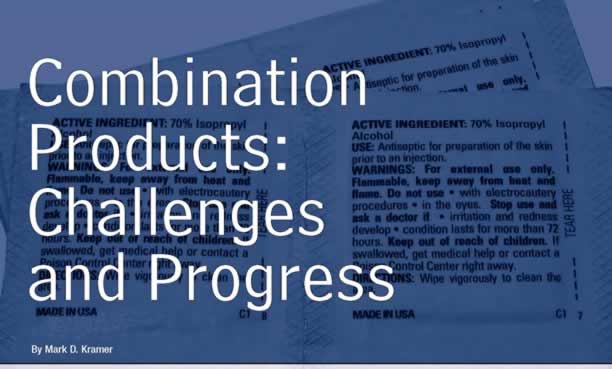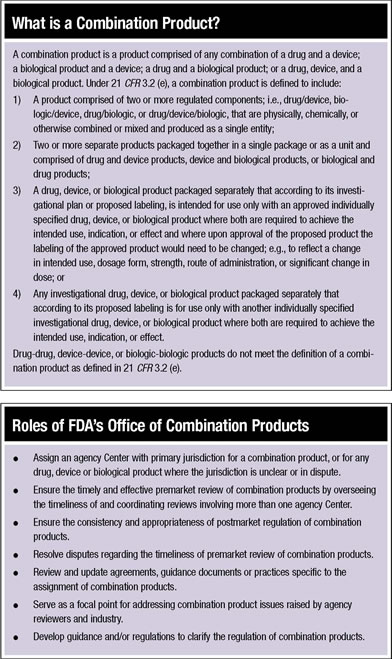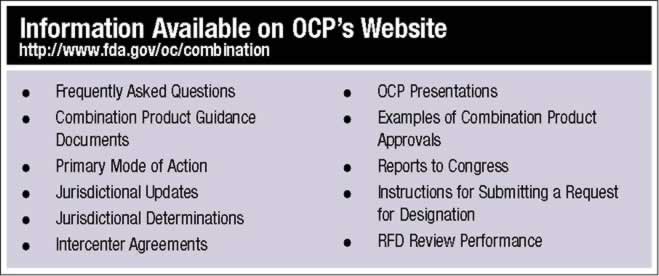 |
 |
FDA
Home Page | Search FDA Site |
FDA A-Z Index | Contact FDA
![]()

Combination products raise a variety of regulatory and review challenges. Though the US regulation of drugs, devices and biological products shares many of the same basic features, each is also somewhat unique. Drugs, devices and biological products each have their own types of marketing applications, good manufacturing practice regulations and adverse event reporting requirements. When drugs and devices, drugs and biologics or devices and biologics are combined to create a new product, questions are sometimes raised about how the combination product as a whole will be regulated. For example, there is no special type of marketing application for combination products. Furthermore, although one Center will lead the premarket review, consultation is frequently required with another FDA Center.
Given the diversity in the types of combination products, a "one size fits all" approach to combination product regulation is probably not the answer. (See Sidebar: What is a Combination Product, page 31). A drug-device combination product, for example, may be comprised of a drug coated on a device, or a drug packaged with a device. Yet another type of drug and device combination is one in which the drug and device components are provided separately, perhaps even by different manufacturers, but are intended to be used together and labeled accordingly. Combination products may be relatively simple (such as a convenience kit with surgical supplies and alcohol wipes, or a syringe prefilled with a drug or biological product) or more complex (such as a drug-eluting coronary stent, a scaffold with live cellular components or a chemotherapeutic drug combined with a monoclonal antibody).
To address these issues and to ensure that combination product regulation is as clear, consistent and predictable as possible, FDA established the Office of Combination Products (OCP), as required by the Medical Device User Fee and Modernization Act of 2002 (MDUFMA).1 OCP's primary responsibilities (See Sidebar: Roles of the Office of Combination Products, page 31) are to ensure the prompt assignment of combination products to agency Centers, and to oversee their "timely and effective" premarket review and "consistent and appropriate" postmarket regulation. OCP also develops guidance and regulations to help clarify combination product regulation. It should be noted that OCP does not review combination products; rather that responsibility is assigned by OCP to the agency's Center for Biologics Evaluation and and Research (CBER), the Center for Drug Evaulation and Research ( CDER) or the Center for Devices and Radiological Health (CDRH), based upon OCP's determination of the combination product's "primary mode of action" 2
OCP establihsed its initial priorities based upon direction from Congress in MDUFMA, as well as input from its stakeholders both within and outside the agency. This article focuses on the progress the agency has made in addressing these priorities.
OCP has taken a multifaceted approach to ensuring the prompt assignment of combination products. Most importantly, FDA published a proposed regulation defining the primary mode of action of a combination product for stakeholder review and comment. This regulation is intended to provide a consistent, predictable and transparent approach to assign combination products to a lead agency component for regulatory oversight.

As described in that proposed regulation, primary mode of action would be defined as the “most important therapeutic action of a combination product.” For example, drug-eluting stents have been assigned to CDRH based upon the agency’s determination that the device’s role in physically maintaining vessel lumen patency provides the most important therapeutic action of the combination product, while the drug plays a secondary role in reducing restenosis caused by the body’s proliferative response to stent implantation.
When the most important therapeutic action of a combination product cannot be determined with reasonable certainty (e.g., the product has two independent modes action, neither of which is clearly subordinate to the other, or the way the product achieves its therapeutic effect is unknown), FDA would base the assignment on an algorithm proposed in the regulation. Under this algorithm, the agency would assign such a combination product to ensure consistency with the assignment of other combination products that present similar safety and effectiveness issues. When no such prior -product exists, FDA would assign the combination product to the agency component with the most expertise to evaluate the most significant safety and effectiveness questions presented by the combination product. FDA is considering stakeholder comments on the proposed regulation and expects to publish a final regulation defining primary mode of action in 2005.
FDA has also responded to stakeholder concerns about the transparency of the jurisdictional process. OCP recently published approximately 140 capsular descriptions of actual product jurisdiction decisions made since 1991.4 In determining whether web-publication of a prior jurisdictional determination is appropriate for a particular product, FDA takes into account the extent to which the product can be suitably described, the extent to which the existence and description of the product or similarly described products has been made public and related factors. The descriptions are intentionally general to ensure the protection of trade secret and confidential commercial information. Jurisdictional determinations are often influenced by subtle distinctions in a product’s composition, mode(s) of action, intended use and related factors, which are not fully reflected in the capsular descriptions. It is possible that a product that fits within one of the general capsular descriptions provided might actually receive a different jurisdictional assignment, based upon the consideration of factors not reflected in the brief capsular description.
To make the assignment process as efficient as possible, the agency has also improved its internal processing of formal requests for assignment (also called Requests for Designation or RFD’s). Thus far, OCP has issued 100% of its jurisdictional decisions within the 60-day timeframe required by law. The Sidebar: Combination Product Assignments (to the right) includes a summary of OCP’s formal jurisdictional assignments for combination products in FDA’s Fiscal 2004, along with statistics on review time performance. Similar information for non-combination products is available on OCP’s website at http://www. fda.gov/oc/combination.
Finally, OCP responds to external and internal stakeholder inquiries by providing advice, guidance and clarification on the assignment of both combination and non-combination products. These come to the office by telephone, email or through “pre-RFD” submissions.
OCP does not review combination products, but it is charged with ensuring their timely and effective premarket review by facilitating and coordinating the review process when more than one agency Center is involved. OCP performs a variety of activities intended to achieve this mission.
One of the first accomplishments was developing and implementing a Standard Operating Procedure for the IntercenterConsultative/Collaborative Review Process. 5 This SOP specifies the procedures and processes followed by CBER, CDER and CDRH staff when working together to review a combination product. This SOP also documents the policy that “Consults Count,” to ensure that the requesting Center receives timely and effective advice. OCP actively monitors the consultation process on combination products (See Sidebar: Intercenter Consultation Requests for Fiscal 2004 , page 32), and has also worked with the Centers to develop more specific processes for particular product areas. OCP is piloting a new system for tracking intercenter consultation requests that will help automate the monitoring process.
| Combination Product Assignments Issued Fiscal 2004 | |
|---|---|
| PRIMARY CENTER | NUMBER OF PRODUCT ASSIGNMENT ISSUED |
| CBER | 3 |
| CDER | 6 |
| CDRH | 17 |
| Total Assigned | 26 |
| Product Assignments Issued Within 60 days | 26 (100%) |
| Median Product Assignment Time | 35 days |
| Range of Product Assignment Time | 18 to 59 days |
| Intercenter Consultation Requests for Fiscal 2004 | |||||
|---|---|---|---|---|---|
| The table below reflects the Intercenter Requests for Consultative or Collaborative Review forms received and monitored by OCP during Fiscal 2004. As the primary assigned Center, CBER requested 20 Intercenter Consultations (four consultations with CDER, 16 consultations with CDRH); CDER requested 59 Intercenter Consultations (two consultations with CBER, 57 with CDRH); and CDRH requested 131 intercenter consultations (nine with CBER, 122 with CDER). | |||||
| CONSULTING CENTER | Number of Consults | ||||
| CBER | CDER | CDRH | |||
| Primary Assigned Center | CBER | ––– | 4 | 16 | 20 |
| CDER | 2 | ––– | 57 | 59 | |
| CDRH | 9 | 122 | ––– | 131 | |
| Totals | 11 | 126 | 73 | 210 | |
One of the most significant ways that OCP helps ensure timely and effective premarket review is by helping applicants and agency reviewers determine the appropriate regulatory pathway for combination products when it is unclear. OCP often facilitates meetings to discuss and resolve such issues at the request of the applicant or review staff. One issue that is sometimes raised concerns whether concomitant use of separately provided drug and device components requires “mutually conforming” or “cross labeling,” thereby creating a combination product. This is a difficult regulatory issue on which OCP cosponsored a workshop in May 2005 to obtain stakeholder input. Information about the workshop, including the workshop transcript, is available on the agency’s website at http://www.fda.gov/oc/combination. 1
FDA is also drafting recommendations to help applicants determine whether single or separate marketing applications are most appropriate for individual combination products. For most combination products, a single marketing application is sufficient for the product’s approval, clearance or licensure. In some cases, however, a sponsor may choose to submit two marketing applications for a combination product when one application would suffice. For example, a sponsor may choose to submit two applications in order to receive some benefit that accrues only from approval under a particular type of application (e.g., new drug product exclusivity, orphan product designation or proprietary data protection when two firms are involved). In other cases, FDA may determine that two marketing applications are necessary. FDA encourages applicants who are uncertain as to whether single or separate marketing applications should be submitted to discuss the issue with the lead reviewing division and/or OCP.
Other work remaining in this area is to better clarify how postapproval modifications to combination products should be handled, i.e., when and how such changes should be submitted to the agency for prior review and approval. In addition, OCP is working with agency Centers to help clarify recommendations for the format and content of combination product marketing applications. As with product jurisdiction questions, applicants may contact OCP at any time if they have questions or would like to discuss whether the approach they are taking seems appropriate.
Combination Product Applications in Fiscal 2004 |
||||||||||
During Fiscal 2004, FDA preliminarily categorized 251 original applications under review as combination products. Of these, CBER received and categorized as combination products 37 applications; CDER received and categorized as combination products 114 applications; and CDRH categorized 100 applications, which were reviewed and acted on as of 30 September 2004. Each combination product is classified into one of 9 categories using a methodology developed specifically for this purpose. The table below reflects the number of original applications preliminarily categorized as combination products in Fiscal 2004. |
||||||||||
APPLICATION TYPE |
COMBINATION PRODUCT CATEGORY – FISCAL 2004 |
|||||||||
1 |
2 |
3 |
4 |
5 |
6 |
7 |
8 |
9 |
TOTALS |
|
Original NDAs |
3 |
13 |
— |
2 |
— |
— |
1 |
— |
— |
19 |
Original BLAs |
1 |
— |
2 |
— |
— |
— |
— |
— |
— |
3 |
Original PMAs |
— |
1 |
— |
3 |
1 |
— |
1 |
1 |
— |
7 |
510(k)s |
1 |
1 |
— |
50 |
4 |
— |
6 |
2 |
3 |
67 |
Original INDs |
3 |
42 |
11 |
5 |
11 |
5 |
13 |
25 |
11 |
126 |
Original IDEs |
— |
— |
— |
16 |
9 |
— |
1 |
1 |
— |
27 |
Original HDEs |
— |
— |
— |
— |
2 |
— |
— |
— |
— |
2 |
TOTALS |
8 |
57 |
13 |
76 |
27 |
5 |
22 |
29 |
14 |
251 |
APPLICATION KEY: NDAs = New Drug Applications BLAs = Biologics License Applications PMAs = Premarket Approval Applications 510(k)s = Premarket Notifications INDs = Investigational New Drug Applications IDEs = Investigational Device Exemptions HDEs = Humanitarian Device Exemptions |
COMBINATION PRODUCT KEY: 1 = convenience kit or co-package 2 = prefilled drug delivery device/system 3 = prefilled biologic delivery device/system 4 = device coated/impregnated/otherwise combined with drug 5 = device coated or otherwise combined with biologic 6 = drug/biologic combination 7 = separate products requiring mutually conforming labeling 8 = possible combination based on mutually conforming labeling of separate products 9 = other type of combination product |
|||||||||
OCP is charged with ensuring the consistency and appropriateness of postmarket regulation of combination products. OCP published a draft guidance document on good manufacturing practice for combination products. 6 The draft makes recommendations for achieving compliance with applicable good manufacturing practice requirements for the drug, device or biological product constituent parts of a combination product where such components are separately marketed. In addition, it makes recommendations for achieving compliance with applicable good manufacturing practice requirements for combination products that are co-packaged or produced as a single entity. The agency believes the draft guidance is responsive to stakeholder concerns that it should generally not be necessary for manufacturers to maintain two separate manufacturing systems (e.g., 21 CFR Parts 210/211 for drugs/biological products and 21 CFR Part 820 for devices) for a combination product.
OCP is also working with other agency components in drafting policy on the application of adverse event reporting regulations for combination products. Guiding principles were developed on factors to be considered when determining appropriate postmarket safety reporting requirements for combination products.

OCP is responsible for resolving disputes regarding the timeliness of review of a combination product. While most issues can be resolved informally, the agency has also published guidance for applicants interested in filing a formal dispute. 7 Another guidance likely to be of interest to manufacturers addresses application user fees for combination products. 8 This guidance describes an Innovative Combination Product Waiver that may be appropriate for innovative combination products in the infrequent situation where FDA determines that two marketing applications are necessary for the product. This waiver may reduce the application fee burden for certain innovative combination products.
OCP conducts a variety of training and outreach sessions for both agency review staff and applicants to help raise awareness of combination product issues and keep stakeholders apprised of policy development. For example, in Fiscal 2004, OCP staff provided 30 presentations to external stakeholders and agency review staff and responded to a variety of press inquiries. OCP also participates in a variety of special agency initiatives of interest to combination product development, e.g., by participating in agency working groups on pharmacogenomic drug/ diagnostic device co-development and innovative delivery systems for drug and biological products. Finally, OCP reports to Congress on an annual basis on the office’s activities and impact. These reports are available on the agency’s website at http://www.fda.gov/oc/combination.
Summary
OCP has made important strides in the two years since it was established, but a good deal of work remains. The agency must consider and incorporate stakeholder comments on all the draft documents published in the last year and issue them in final form. Several other draft documents currently in development still need to be published for stakeholder review and comment and, in turn, finalized. A variety of other issues must be clarified where applicability of current regulations to combination products is unclear. Importantly, FDA must evaluate the impact of all that has been done and determine whether any revisions are needed. Based upon that evaluation, the agency will decide whether any legislative changes should ultimately be recommended in order to achieve its goals of ensuring a comprehensive framework that provides for the most appropriate regulation of any given combination product.
OCP is available as a resource at any time during a combination product’s lifecycle. The staff is glad to help resolve questions, general or specific, or to receive comments about the work it is doing. OCP can be contacted by telephone at 301.427.1934 or by email at combination@fda.gov.
![]()